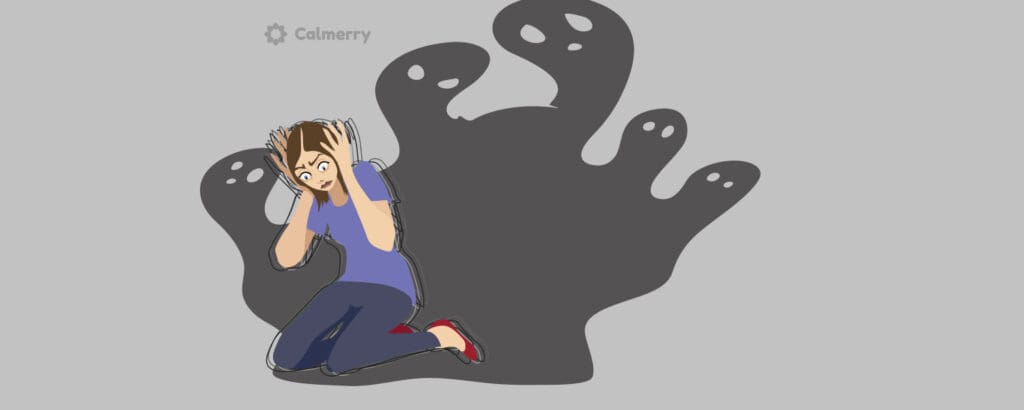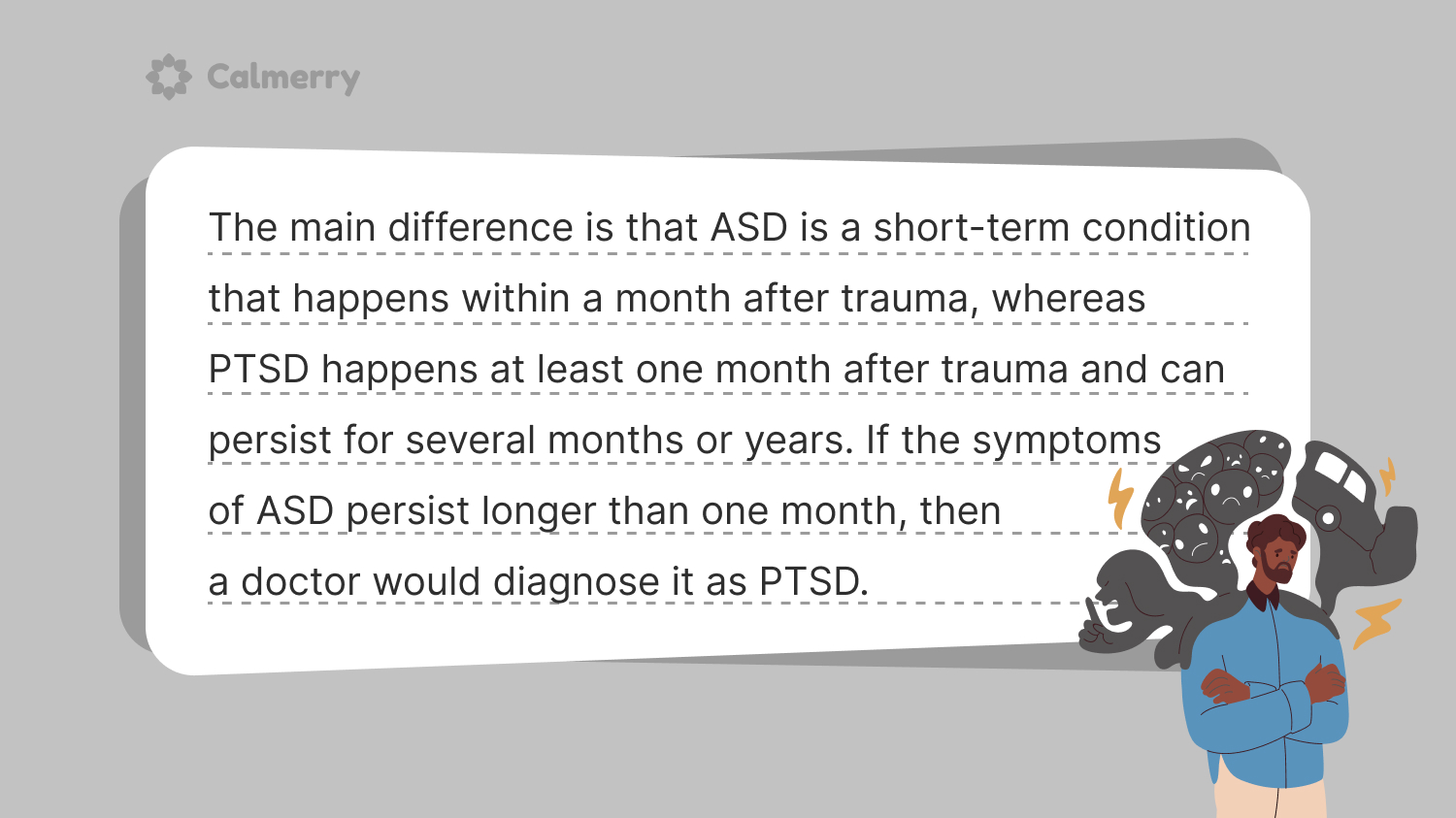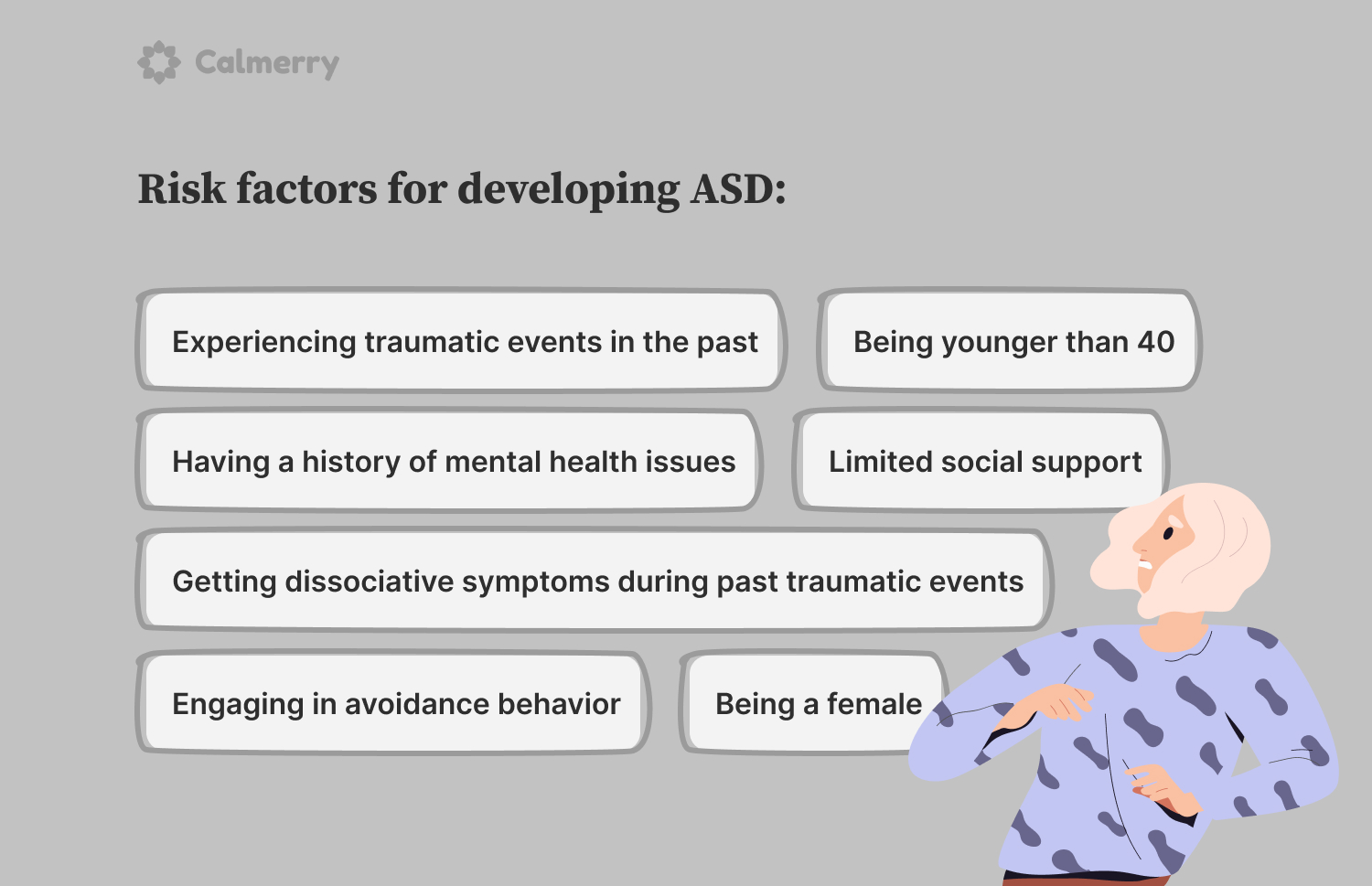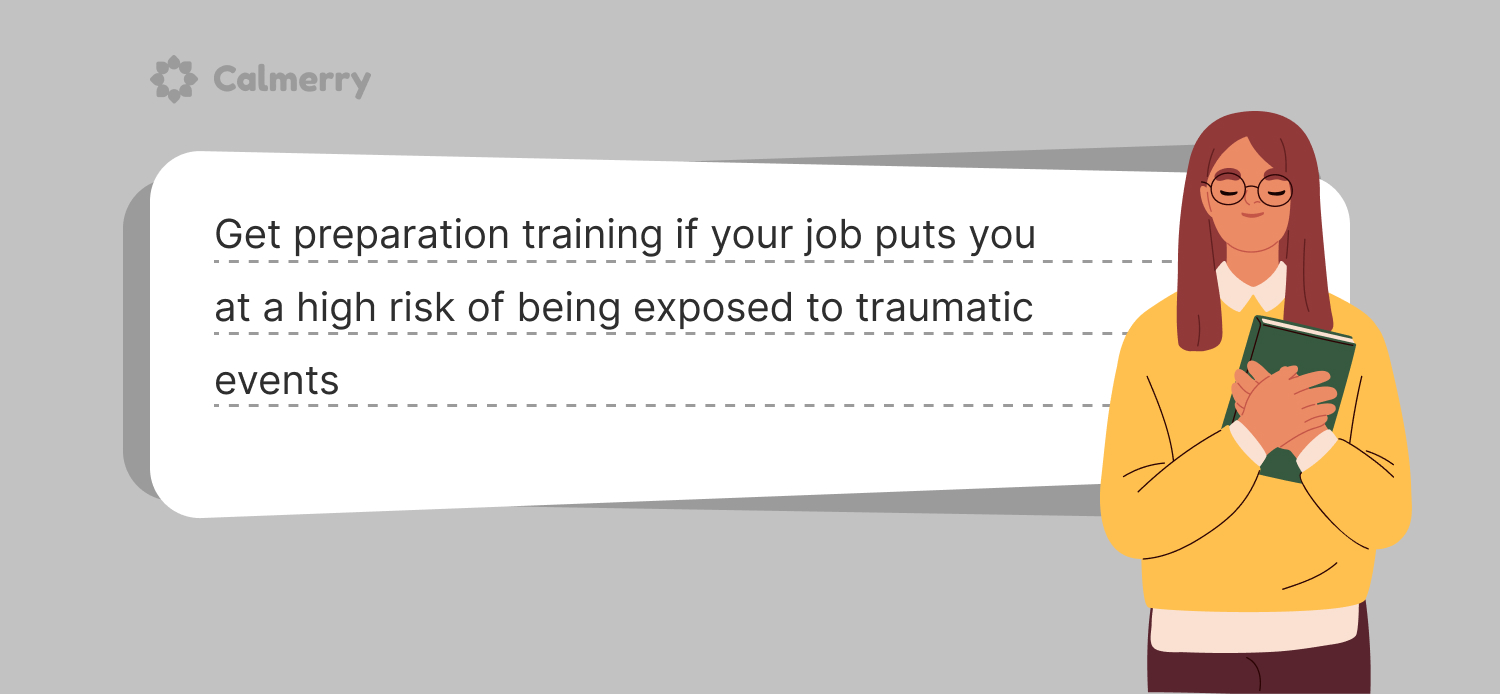Acute Stress Disorder: Everything You Need to Know

In this article
Studies show that over 70% of adults in the US experience at least one potentially traumatic event in their lifetime. Unfortunately, trauma is common, and when it occurs, there’s a real risk of developing acute stress disorder (ASD).
Acute stress disorder is a short-term mental health condition closely linked to post-traumatic stress disorder (PTSD). Its symptoms can be distressing and debilitating, but most people do recover from it.
In this article, we’ll take a closer look at what acute stress disorder is, its causes, symptoms, treatment, and prevention options, with a focus on how Calmerry can support individuals in their journey to recovery.
What is acute stress disorder (ASD)?
Acute stress disorder (ASD), also sometimes referred to as acute stress reaction, is an anxiety disorder that can develop within one month after a traumatic event.
It’s a temporary condition that lasts a minimum of 3 days and a maximum of 30 days. On average, 19% of people develop ASD following a traumatic event, but the rate does vary depending on the type of trauma.
ASD symptoms can cause significant distress, impair functioning, and are similar to post-traumatic stress disorder (PTSD).
Acute stress disorder vs. PTSD
There is a close link between ASD and post-traumatic stress disorder (PTSD), as both are caused by direct or indirect exposure to one or more traumatic events. Some people with ASD go on to develop PTSD, yet people can also develop PTSD (up to 11.2%) without having ASD prior.
The main difference is that ASD is a short-term condition that happens within a month after trauma, whereas PTSD happens at least one month after trauma and can persist for several months or years. If the symptoms of ASD persist longer than one month, then a licensed professional would diagnose it as PTSD.

Symptoms of acute stress disorder
In the most recent diagnostic and statistical manual of mental disorders, dissociative symptoms are no longer required to diagnose ASD while still including it as a diagnostic criterion that people may experience.
There are five main categories of symptoms that people with ASD experience, including the following psychological and behavioral symptoms:
- Dissociative symptoms. Feeling detached, numb, or dazed, difficulty remembering parts of the traumatic event (dissociative amnesia), decreased awareness of your surroundings, and an altered sense of reality or perception of time.
- Intrusions. Re-experiencing the traumatic event through recurring, involuntary memories, flashbacks, nightmares, or thoughts and experiencing distress when things remind you of the traumatic event.
- Avoidance. Actively avoiding people, thoughts, feelings, conversations, places, activities, objects, or anything else you associate with the traumatic event out of fear of being reminded of it.
- Arousal or anxiety. Irritability, anger, or aggression (verbal or physical), difficulty sleeping, trouble concentrating, an inability to sit still, feeling constantly tense and on guard, and being easily startled.
- Mood. Having negative thoughts, being unable to experience positive emotions, and feeling down, sad, low, or depressed.
People with ASD can also experience physical symptoms caused by stress hormones like adrenaline and the overactivity of the nervous system. These include:
- Heart palpitations
- Difficulty breathing
- Nausea
- Headaches
- Chest pains
- Stomach ache
What causes acute stress disorder?
Experiencing terrifying or traumatic events can cause ASD. These events often involve death, life-threatening situations, or the risk of significant physical, mental, or emotional harm.
Traumatic events that lead to ASD are often sudden or unexpected. They might involve you directly, or you might witness them happening.
Here are some examples of traumatic events that can cause ASD:
- Road traffic accidents
- Natural disasters (earthquakes, floods, hurricanes, etc.)
- Sexual assault
- Physical assault
- Emotional abuse
- Domestic abuse
- Terrorist attacks
- War or conflict
- Severe injuries
- Torture
- You or a loved one receiving a life-threatening diagnosis
- The loss of a loved one
However, keep in mind that many other types of traumatic events that we haven’t listed above could also cause ASD.
Risk factors
While anyone can develop ASD, certain factors may increase the risk of someone developing it. These include:
- If you have experienced or witnessed a traumatic event in the past
- If you have a history of mental health issues like anxiety or depression
- If you have experienced dissociative symptoms during past traumatic events
- If you have limited social support
- If you engage in avoidance behavior
- If you are female
- If you are younger than 40 years of age
- If you have an intellectual disability
- If you live with personality disorder(s)
- Lack of education
- Trauma severity

When to seek help
If you have been exposed to trauma and have limited social support, talking to a licensed therapist is a great option. Seeking professional help soon after a traumatic experience can reduce the risk of developing ASD and PTSD both.
If you have witnessed a traumatic event and are experiencing any ASD symptoms, we recommend seeking help from a licensed health professional right away.
Diagnosis
To diagnose ASD, your doctor or a mental health specialist will ask about your symptoms and the traumatic event you experienced. They may also ask about your health and lifestyle.
The evaluation helps them make an accurate diagnosis and rule out any other possible causes of your symptoms, such as underlying health problems or the use of medication or drugs.
You will usually be diagnosed with ASD if you meet the following criteria:
- If you have directly or indirectly experienced a traumatic event
- If you have experienced at least nine of the ASD symptoms (see above for symptom details)
- If your symptoms have persisted for at least three days and fewer than 30 days
- If your symptoms occurred within one month after the traumatic event
- If your symptoms are causing significant distress and affecting daily life
- If they can rule out all other possible causes of your symptoms
How to treat acute stress disorder
Some people can recover from ASD without needing treatment. Especially if they are safe, not exposed to more trauma, prioritize self-care, and receive support from friends or family.
However, treatment can still be beneficial as it eases the symptoms, helps you develop effective coping strategies, and reduces the risk of PTSD. The primary treatment for ASD is trauma-focused cognitive behavioral therapy (TF-CBT), but sometimes medication can be prescribed.
Trauma-focused cognitive behavioral therapy (TF-CBT)
TF-CBT is a type of cognitive behavioral therapy specially adapted for ASD and PTSD. It can aid recovery and reduce the risk of ASD progressing into PTSD.
TF-CBT usually happens over several weekly sessions. It involves talking through your trauma with a counselor, learning about trauma-related disorders, and learning to restructure your thoughts to overcome unhelpful thinking patterns, behaviors, and fears associated with the trauma. Second, it tries to alter behaviors in anxiety-provoking situations, often referred to as exposure.
Medication
Medication is sometimes prescribed short-term in low doses to help alleviate anxiety, insomnia, or physical symptoms. This may include beta-blockers or benzodiazepines like clonazepam (this is not recommended for those with a substance abuse history). Doctors do not usually recommend antidepressants.
Long-term use of medications may lead to dependence and can even increase the likelihood of PTSD developing.
Self-care strategies for ASD
If you have recently experienced a traumatic event or have ASD, here are some things you can do to support yourself.
Seek safety
Knowing that you and your loved ones are safe and out of harm’s way is reassuring and lets you begin processing your traumatic experiences. Some circumstances like domestic abuse or conflict can make it difficult to escape a traumatic environment. In such cases, you should seek expert help to learn how to cope with it better. It is difficult to heal in the same environment that caused the harm.
Practice self-care
Eating healthily, exercising, spending time outside, and sleeping well are some of the things you can do to help you feel better. Avoiding or not over-indulging in drugs and alcohol is also a great suggestion.
Try mindfulness
Meditation, breathing techniques, and other mindfulness exercises can help you manage anxiety and stress. Mindfulness exercises can also improve your ability to concentrate, improve your mood, and help with sleeping difficulties.
This can also be used to identify thought distortions that have been created in reaction to the traumatic experience. It can be helpful to separate out the thought from the emotion and physiological experience. Awareness is a critical step in interrupting harmful dynamics that fuel ASD symptoms.
Reach out to others
If you can, try sharing your experiences or feelings with a trusted friend, relative, support group, or licensed therapist. Even something as simple as hanging out with friends can help you feel better and boost your self-esteem.
Do things you enjoy
It is easy to get trapped in a distressed state by constantly thinking and replaying traumatic events in your mind. A proper distraction can do wonders here, so don’t hesitate to get back into things that you enjoy, whether it’s reading a book, cooking, watching a movie, playing games, or anything else.
These activities help you focus on other things and improve your mood.
Give yourself time
It’s normal to feel sad or anxious after a traumatic event. However, don’t judge yourself too harshly for feeling this way, show yourself kindness and compassion, and be okay with the fact that you may need a little time to recover.
Leaning into the emotion and validating feelings as they occur can significantly help process the traumatic event and prevent prolonged symptoms of ASD that can turn into PTSD.
Prevention
While there’s no way to guarantee you’ll never experience a traumatic event, there are some things you can do afterward to decrease the risk of ASD developing. These include:
- Consult a licensed therapist, mental health specialist, or doctor as soon as possible after a traumatic event
- Seek support from people you trust
- Don’t neglect self-care
- Get preparation training if your job puts you at a high risk of being exposed to traumatic events

Summing up
Most of us will experience a traumatic event at some point in our lives, and unfortunately, some will go on to develop ASD and possibly even PTSD. However, following the outlined advice could help you prevent the development of ASD, build effective coping methods, or take the steps needed to treat it.
Seeking professional help is one of the best steps to take following a traumatic event. Finding a counselor well-versed in using evidence-based therapies like trauma-focused cognitive behavioral therapy can help you overcome ASD and process your traumatic experience in a healthy way.
online therapy
live video session



